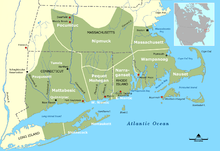Metoac
This article needs additional citations for verification. (May 2016) |

Metoac is an erroneous term used by some to group together the
Instead, Indian peoples on Long Island at the time of European contact came from only two major language and cultural groups of the many
Wood (and earlier colonial settlers) often confused Indian place names, by which the bands were known, as the names for different tribes living there.Many of the place names that the Lenape and Pequot populations used to refer to their villages and communities were adopted by English settlers and are still in use today. The Shinnecock Indian Nation, based in part of what is now Southampton, New York in Suffolk County, has gained federal recognition as a tribe and has a reservation there.
Etymology
"Metoac" as a collective term may have been derived by Wood from metau-hok, the Algonquian word for the
Languages
The Native American population on Long Island has been estimated at 10,000 at the time of first contact with Europeans.
European colonization
European colonization of the region began in the 1620s, with Dutch colonists congregating around the lower Hudson and western Long Island. The Dutch attempted to establish jurisdiction from
Displacement
The
By this time,
Exonyms
For generations, colonists mistakenly used the place names as
Metoac was a term erroneously used by amateur
| Name | Alternate names | Location | Modern place names | Notes |
|---|---|---|---|---|
| Canarsie | Carnasee | modern-day Jamaica, New York
|
Canarsie, Brooklyn | According to legend, the Carnarsie sold Manhattan to the Dutch Governor Peter Minuit for "24 dollars' worth of beads and trinkets."[8] |
| Corchaug | Cochaug, Cutchogue | around Riverhead and Southold, New York on eastern Long Island | Cutchogue, New York | The Fort Corchaug Archaeological Site is on the National Register of Historic Places. |
| Manhasset | Manhansick | Shelter Island, New York
|
Manhasset, New York | |
| Marsapeague | Massapequa, Marsapequa, Maspeth | south shore, from the Rockaways east into Suffolk County. | Maspeth, Queens
|
|
| Matinecock | Matinecoc | Long Island North Shore from Flushing, Queens to Huntington
|
Matinecock, New York | |
| Mericoke | Merrick, Meroke, Merikoke, Meracock | south shore from the Rockaways into Suffolk County | Merrick, New York | |
| Montaukett | Montauk, Meanticut | East Hampton, New York
|
Montauk, New York | Its Wyandanch had his name on the title transfer of most of Long Island to the European settlers
|
| Nissequaq | Nesaquake, Missaquogue | North Shore from Fresh Pond to Stony Brook in Suffolk County | Nissequogue, New York and the Nissequogue River | |
| Rockaway | Rechaweygh, Rechquaakie | around Maspeth
|
The Rockaways is a place name derived from this. | |
| Secatague | Secatoag, Secatogue | Islip on the south shore.
|
||
| Setauket | Setalcott | North Shore from Stony Brook to Wading River, New York | Setauket, New York | |
| Shinnecock | Southampton | Shinnecock Hills, New York and Shinnecock Inlet | The federally recognized tribe occupies the Shinnecock Reservation, New York .
| |
| Unkechaug | Patchogue, Onechechaug, Patchoag, Unchachaug, Unquaches, Unquachog, Unquachock, Unchechauge | south shore from Southampton, New York
|
Patchogue, New York | The Unkechaug have retained a community on the Poospatuck Reservation in Mastic, New York. It is recognized by the state of New York, though not federally recognized. |
State and federal recognition

New York State has officially recognized the self-identified Shinnecock and the Unkechaug on Long Island as Native American tribes. The Shinnecock are based at
Since the mid-20th century, the Montaukett, Setalcott, and Matinnecock peoples have organized and established governments. All are seeking both state and federal recognition.
At the end of 2009, the administration of President Barack Obama announced the Shinnecock Indian Nation had met federal criteria as a tribe.[9] The Shinnecock were officially recognized by the United States government in October 2010 after a more than 30-year effort, which included suing the Department of Interior.[10] The Acting Principal Deputy Assistant Secretary of Indian Affairs, George T. Skibine, issued the final determination of the tribe's recognized status on June 13, 2010.[11]
References
- ^ ISBN 978-1-55787-148-0
- ^ ISBN 978-0-231-11452-3.
- ISBN 9780403097722. Retrieved 2015-04-14.
- ^ longislandsoundstudy.net/about-the-sound/history/
- ^ montaukclub.com/the-montauk-club/.../the-montauk-tribe/
- ISBN 978-1-4259-3405-7
- ^ Nathaniel Scudder, A History of Long Island From Its First Settlement By Europeans to the Year 1845, New York: 1845
- ^ Islands Draw Native American, Dutch, and English Settlement, City-data.com, Retrieved December 1, 2007.
- ^ Hakim, Danny (2009-12-15). "U.S. Eases Way to Recognition for Shinnecock". New York Times. Retrieved 2009-12-17.
- ^ Hakim, Danny (June 15, 2010). "U.S. Recognizes an Indian Tribe on Long Island, Clearing the Way for a Casino". The New York Times. Retrieved 2010-06-15.
- ^ Darling, Nedra. "Skibine Issues a Final Determination to Acknowledge the Shinnecock Indian Nation of Long Island, NY. Archived 2010-12-05 at the Wayback Machine Office of the Assistant Secretary-Indian Affairs. 15 June 2010 (retrieved 12 July 2010)
